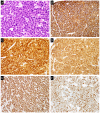The Role of c-MYC in B-Cell Lymphomas: Diagnostic and Molecular Aspects
- PMID: 28379189
- PMCID: PMC5406863
- DOI: 10.3390/genes8040116
The Role of c-MYC in B-Cell Lymphomas: Diagnostic and Molecular Aspects
Abstract
c-MYC is one of the most essential transcriptional factors, regulating a diverse array of cellular functions, including proliferation, growth, and apoptosis. Dysregulation of c-MYC is essential in the pathogenesis of a number of B-cell lymphomas, but is rarely reported in T-cell lymphomas. c-MYC dysregulation induces lymphomagenesis by loss of the tight control of c-MYC expression, leading to overexpression of intact c-MYC protein, in contrast to the somatic mutations or fusion proteins seen in many other oncogenes. Dysregulation of c-MYC in B-cell lymphomas occurs either as a primary event in Burkitt lymphoma, or secondarily in aggressive lymphomas such as diffuse large B-cell lymphoma, plasmablastic lymphoma, mantle cell lymphoma, or double-hit lymphoma. Secondary c-MYC changes include gene translocation and gene amplification, occurring against a background of complex karyotype, and most often confer aggressive clinical behavior, as evidenced in the double-hit lymphomas. In low-grade B-cell lymphomas, acquisition of c-MYC rearrangement usually results in transformation into highly aggressive lymphomas, with some exceptions. In this review, we discuss the role that c-MYC plays in the pathogenesis of B-cell lymphomas, the molecular alterations that lead to c-MYC dysregulation, and their effect on prognosis and diagnosis in specific types of B-cell lymphoma.
Keywords: c-MYC; complex karyotype; diffuse large B-cell lymphoma; double-hit lymphoma; lymphoma; mantle cell lymphoma; plasmablastic lymphoma.
Conflict of interest statement
The authors declare no conflict of interest.
Figures


References
-
- Bishop J.M. Retroviruses and cancer genes. Adv. Cancer Res. 1982;37:1–32. - PubMed
-
- Taub R., Kirsch I., Morton C., Lenoir G., Swan D., Tronick S., Aaronson S., Leder P. Translocation of the c-myc gene into the immunoglobulin heavy chain locus in human Burkitt lymphoma and murine plasmacytoma cells. Proc. Natl. Acad. Sci. USA. 1982;79:7837–7841. doi: 10.1073/pnas.79.24.7837. - DOI - PMC - PubMed
Publication types
LinkOut - more resources
Full Text Sources
Other Literature Sources

